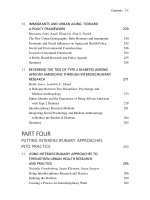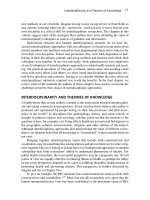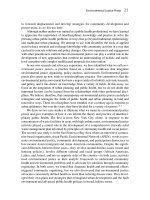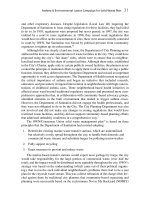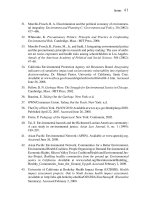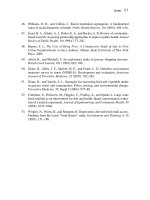Urban Health and Society: Interdisciplinary Approaches to Research and Practice - Part 32 pps
Bạn đang xem bản rút gọn của tài liệu. Xem và tải ngay bản đầy đủ của tài liệu tại đây (142.89 KB, 10 trang )
Notes 291
63. Crane, J. G., and Angrosino, M. V. Field Projects in Anthropology. Prospect
Heights, Ill.: Waveland Press, 1992.
64. Hammersley, M., and Atkinson, P. Ethnography: Principles in Practice. London:
Routledge, 1995.
65. Bernard, H. R. Research Methods in Anthropology. Walnut Creek, Cal.: AltaMira,
2002.
66. Creswell, J. W., Plana Clark, V. L., Gutmann, M. L., and Hanson, W. E. Advanced
mixed methods research designs. In A. Tashakkori and C. Teddlie, eds., Hand-
book of Mixed Methods in Social and Behavioral Research, pp. 209 – 240.
Thousand Oaks, Cal.: Sage, 2003.
67. Creswell, J. W. Research Design: Qualitative, Quantitative, and Mixed Methods
Approaches. Thousand Oaks, Cal.: Sage, 2003.
68. Creswell, J. W., Fetters, M. D., and Ivankova, N. V. Designing a mixed methods
study in primary care. Annals of Family Medicine, 2, no. 1 (2004): 7 – 12.
69. Sarkisian, C. A., Brusuelas, R. J., Steers, W. N., et al. Using focus groups of older
African Americans and Latinos with diabetes to modify a self - care empower-
ment intervention. Ethnic Discussion, 15 (2005): 203 – 291.
70. Seidman, I. Interviewing as Qualitative Research: A Guide for Researchers in
Education and the Social Sciences. New York: Teachers College Press, 1998.
71. Trochim, W. M. K. The Research Methods Knowledge Base, 2nd ed. Cincinnati,
Oh.: Atomic Dog Publishing, 2001.
72. Baptiste - Roberts, K., Gary, T. L., Bone, L. R., Hill, M. N., and Brancati, F. L.
Perceived body image among African Americans with type 2 diabetes. Patient
Education and Counseling, 60 (2006): 194 – 200.
c11.indd 291c11.indd 291 6/3/09 12:06:44 PM6/3/09 12:06:44 PM
c11.indd 292c11.indd 292 6/3/09 12:06:44 PM6/3/09 12:06:44 PM
PART
4
PUTTING
INTERDISCIPLINARY
APPROACHES
INTO PRACTICE
c12.indd 293c12.indd 293 6/3/09 12:07:54 PM6/3/09 12:07:54 PM
c12.indd 294c12.indd 294 6/3/09 12:07:54 PM6/3/09 12:07:54 PM
CHAPTER
1 2
USING
INTERDISCIPLINARY
APPROACHES TO
STRENGTHEN URBAN
HEALTH RESEARCH
AND PRACTICE
NICHOLAS FREUDENBERG, SUSAN KLITZMAN,
SUSAN SAEGERT
LEARNING OBJECTIVES
■ Describe the rationale for using interdisciplinary research approaches to study
urban health problems.
■ Discuss the stages of the interdisciplinary research process (defi ning the problem,
creating and implementing a process, choosing partners, infl uencing policy and
practice, and evaluating impact) and describe the key tasks in each stage.
c12.indd 295c12.indd 295 6/3/09 12:07:54 PM6/3/09 12:07:54 PM
296 Using Interdisciplinary Approaches to Strengthen Urban Health Research
■ Analyze the unique challenges that face evaluators of interdisciplinary
interventions to improve urban health.
■ Identify specifi c ways that you can use interdisciplinary research approaches in
your professional practice.
DOING INTERDISCIPLINARY RESEARCH AND PRACTICE
In the previous chapters of this volume, researchers from a variety of disciplines, pro-
fessions, and specialization areas — including American studies, anthropology, eco-
nomics, environmental health sciences, epidemiology, geography, health education,
medicine, nutrition, political science, psychology, public health, social ecology, socio-
logy, and urban planning — considered a range of urban health and social issues —
including aging, air pollution, asthma, child development and poverty, diabetes,
disasters, homelessness, housing foreclosures, hunger, immigration, obesity, racism,
and tobacco use. The stories that emerge from these dizzying lists of disciplines and
problems illustrate the complex challenges that face those seeking to improve the well -
being of urban populations and the need for urban health researchers and practitioners
to be able to cross traditional academic and professional boundaries if they are to be
effective.
In this fi nal chapter, we consider some of the central themes that run through this
volume. Our focus is on doing interdisciplinary research and practice in urban health.
In the last decade, a lively scholarly debate on the meaning, value, and tensions within
inter - and transdisciplinary research has emerged.
1
,
2
,
3
,
4
However, our aim here is more
practical: We seek to help readers move from an appreciation of interdisciplinary
research to a capacity to do it — to apply the principles, concepts, and skills described
in the previous chapters and developed elsewhere in recent years to their roles as urban
health professionals and researchers.
We examine what we have learned about the practical application of the approaches,
methods, and frameworks the authors describe and how our readers can apply these
lessons in their work settings. Our sources for this discussion are the prior chapters,
our own research and practice, described briefl y in Chapter One , and our understand-
ing of the recent literature on interdisciplinary research and practice. In the last several
years, some new volumes and special journal issues on interdisciplinary research have
been produced. These are described briefl y in Table 12.1 , and we encourage interested
readers to consult these sources for a deeper understanding or for guidance on selected
issues. Although much of the new attention to interdisciplinary research has emerged in
the United States and Europe, it has also attracted researchers in Africa, Latin America,
and Asia, suggesting its relevance in both the developed and developing world.
5
,
6
,
7
In Figure 12.1 , we present a schematic of the stages involved in doing interdisci-
plinary work on urban health. We conceptualize the process as a cycle — shown as a
circle — in which researchers begin by defi ning the problem and then create a process for
addressing the problem and implementing the research. Once the team of researchers
c12.indd 296c12.indd 296 6/3/09 12:07:55 PM6/3/09 12:07:55 PM
Doing Interdisciplinary Research and Practice 297
TABLE 12.1. Selected Recent Works on Interdisciplinary Research
Title and authors
Publisher and
publication
date Brief description
Creating Interdisciplinarity:
Interdisciplinary Research and
Teaching Among College and
University Faculty. Lattuca, L.
Vanderbilt
University Press,
2001
Analyzes the processes by which
faculty from different disciplines pursue
interdisciplinarity in their teaching and
research across departments, disciplines,
and institutions.
Expanding the Boundaries of
Health and Social Science: Case
Studies in Innovation. Kessel, F.,
Rosenfi eld, P. L., and Anderson,
N. B., editors
Oxford
University Press,
2003
Case studies of application of
interdisciplinary methods on topics
from brain science to HIV and human
resilience. Prepared by Social Science
Research Council and Offi ce of
Behavioral and Social Science Research
at National Institute of Health.
Facilitating Interdisciplinary
Research. Committee on
Facilitating Interdisciplinary
Research
National
Academies
Press, 2005
A review of interdisciplinary research
with a focus on the organizational
and institutional factors that facilitate
or block this approach. Sponsored by
the National Academies of Sciences
and Engineering and the Institute of
Medicine.
Handbook of Transdisciplinary
Research. Hirsh - Hadorn, G.,
Hoffman - Riem, H., Biber -
Klemm, S. et al., editors
Springer, 2008 Provides an overview of transdisciplinary
research as applied to problems at
the interface of science, society, and
politics; most contributors are European
researchers. Prepared by the Swiss
Academies of Arts and Sciences.
Special Issue of American
Journal of Preventive Medicine,
“ The Science of Team Science. ”
Stokols, D., Hall, K. L., Taylor,
B. K., Moser, R. B., and
Syme, S. L.
Volume
35, Special
Supplement,
August 2008
Twenty articles on “ team science ”
with sections on origins, theoretical
perspectives, methodological
contributions, the r
ole of systems
thinking, and future directions for the
“ science of team science. ”
c12.indd Sec1:297c12.indd Sec1:297 6/3/09 12:07:55 PM6/3/09 12:07:55 PM
298 Using Interdisciplinary Approaches to Strengthen Urban Health Research
is assembled, they will usually need to fi nd other partners to help them understand the
problem and carry out the research. Next the investigators look for ways to use their
fi ndings to infl uence policy and practice. Finally, the team evaluates the impact of
their work to guide the next steps. Although the diagram shows the stages proceeding
in a clockwise direction, in fact, research teams may on occasion return to previous
stages. For example, after bringing in new partners, a team may choose to redefi ne the
problem. In Chapter Seven , for example, it was only after talking to individuals who
had experienced foreclosure that Saegert and her colleagues grasped its impact on
health, thus modifying their research questions. Figure 12.1 also focuses on the
research process itself rather than calling attention to the dynamic context in which
the problem is unfolding. Again using the chapter on foreclosure and health as an
example, as the research progressed, the media, political, and economic context
moved from widespread denial of the foreclosure crisis to active engagement. This
change affected the ways in which the research can lead to policy change and
interventions.
Thus, we see interdisciplinary research as a dynamic and iterative process in which
investigators move between steps in both directions as one set of problems is solved and
new issues emerge. In the following pages, we discuss some of the issues that research
teams face at each stage of the process, using examples from the previous chapters.
FIGURE 12.1 Stages of Interdisciplinary
Work on Urban Health
Evaluating
impact
Defining the
problem
Creating and
implementing
a process
Influencing
policy and
practice
Choosing
partners
c12.indd Sec1:298c12.indd Sec1:298 6/3/09 12:07:55 PM6/3/09 12:07:55 PM
Defi ning the Problem 299
DEFINING THE PROBLEM
Only when a problem is clearly articulated can researchers decide whether or not it
warrants interdisciplinary rather than disciplinary investigation. First, let ’ s consider
how to determine whether or not a problem meets the criteria for interdisciplinary
research, and then let ’ s take a step back and ask how best to frame a problem so as to
defi ne a researchable question.
Not every problem — not even every urban health problem — requires interdisci-
plinary research or intervention to solve. But in many of the case studies presented in
this volume, the impetus for using an interdisciplinary approach to research or inter-
vention was not an ideological commitment to interdisciplinarity but rather a conse-
quence of the nature of the problem itself. What are some of the indications for an
interdisciplinary rather than a disciplinary approach? And what kinds of problems are
more suited to this approach?
First, investigators need to ask whether the problem ’ s causes or consequences
cross levels of organization. If they do, it may be that a single discipline will be insuffi -
cient. Second, if the investigators seek to solve as well as describe the problem they
are studying — a basic premise of public health — then they need to ask whether their
discipline has all or most of the tools needed for solution. If not, a broader team may
be needed. Another way of saying this is to posit that if researchers want to move from
basic or etiological research to applied work, from laboratory to bedside to population,
a process recently labeled as translational science,
8
they probably need an interdisci-
plinary team. Third, if the problem is embedded in a complex social and physical envi-
ronment or if it cuts across multiple sectors, more than one discipline may be needed
to understand the infl uences of these external factors. Fourth, if researchers seek to
address fundamental as well as proximate causes of a health problem, they may need
to include researchers who can travel both upstream and downstream to understand
these different levels of causes and the pathways by which they infl uence health.
Finally, the research team needs to consider the scope of its mandate. If researchers are
charged by larger social institutions with answering a narrow and specifi c question, a
single discipline may suffi ce, whereas if the directive is to fi x the problem, more com-
plex investigations will be needed. For example, if researchers want to bring their fi ndings
into policy and practice arenas, they may need to fi nd colleagues in other disciplines.
To illustrate, let ’ s take the example of childhood asthma, a problem considered in
Chapter Two. If the question is whether a particular medical treatment is effective in
reducing asthma symptoms among children, a research team of one or two disciplines
could probably design and carry out a study to answer it. If, however, the question is
how to get an effective drug to the children who need it, how to help parents ensure
their asthmatic children take the medicine properly, how to make sure that local health
providers use the medicine effectively, or how to combine medical treatment with
household or neighborhood environmental modifi cation to further reduce symptoms,
then the research team will need a much wider cast of characters. In sum, both the
scope of the health problem under investigation and the types of questions that need to
be answered dictate whether or not to use interdisciplinary research.
c12.indd Sec2:299c12.indd Sec2:299 6/3/09 12:07:55 PM6/3/09 12:07:55 PM
300 Using Interdisciplinary Approaches to Strengthen Urban Health Research
Framing the Problem
In every research endeavor, framing the problem is a key starting task. Interpreting the
framing of social problems has recently emerged as a popular strategy in communica-
tions, social science, and public health research.
9
,
10
“ Frames ” have been described as
tools for defi ning a problem, diagnosing its cause, justifying solutions, and predicting
its likely effects.
10
In many complex questions that bring together multiple actors and stakeholders
and draw on expertise of multiple disciplines, building in a refl ection and possible
reframing moment early in the process is wise.
Researchers and public health professionals always have choices in how to frame
a problem. The decisions they make structure their opportunities for posing research
questions and designing studies or interventions. How to frame a problem is both a
scientifi c question and a political question — scientifi c in that it requires evidence and
hypotheses on the more and less important causal factors and consequences and politi-
cal in that any solution requires understanding who has power to solve the problem
and what will move them to act. Although some researchers seek to avoid the second
question, it is our belief that the public health ethic requires considering both simulta-
neously because the imperative is to improve population health, not simply to describe
or analyze it.
To aid in our understanding of how framing a problem infl uences decisions about
interdisciplinary research, we use the example of diabetes, a problem considered in
Chapter Eleven . Diabetes can be considered from several different perspectives — for
example, as a metabolic problem requiring adjustments in glucose metabolism, as a
medical problem requiring effective medical management to prevent complications
and treat symptoms, as a public health problem requiring control programs that reduce
social and environmental risk factors and incidence in the population as a whole, as
a social justice problem requiring efforts to shrink the growing disparities in morbidity
and mortality among different socioeconomic and racial/ethnic groups, or as an eco-
nomic problem imposing a growing burden on our work force, economy, and health
care system. Each of these frames suggests a different solution and requires a different
team of investigators to fi nd answers. In Chapter Eleven , Jones and Liburd suggest
that cultural and sociopolitical factors play a key role in shaping the differential impact
dia betes has on different populations; they suggest that effective interventions may
need to involve and be tailored to specifi c subpopulations.
No frame is by itself right or wrong, but the challenge is to match the frame of the
problem with the expertise and mandate that researchers have to understand and
address it. The case we make here and in the volume as a whole is that if the mandate
is for researchers to improve the health of urban populations, then a broad, multilevel,
and intersectoral framing of the problem is often more likely to lead to effective solu-
tions than a narrower one. In the fi rst chapter, we described the characteristics of cities
that justifi ed such an approach — population density and diverse, complex systems, a
multiple array of human and social resources, and high levels of inequality. Health
c12.indd Sec2:300c12.indd Sec2:300 6/3/09 12:07:56 PM6/3/09 12:07:56 PM


